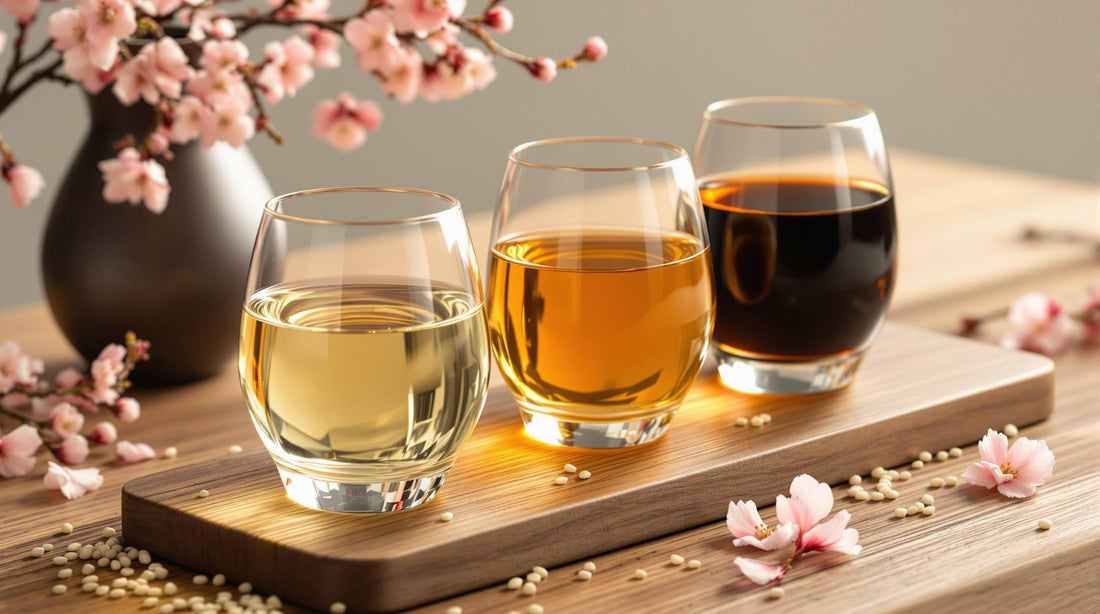
Understanding Sake Mouthfeel
Share
Sake mouthfeel refers to the texture, weight, and physical sensations you experience while drinking sake. Here's what you need to know:
-
Key Factors Influencing Mouthfeel:
- Rice Polishing Ratio: Higher polishing (e.g., Daiginjo) leads to smoother, delicate textures.
- Brewing Methods: Low-temperature, long fermentation produces refined textures, while higher temperatures create bolder sensations.
- Serving Temperature: Chilled sake feels crisp and refreshing; warm sake feels rich and full-bodied.
-
Sake Types and Textures:
- Junmai: Full-bodied, rich.
- Ginjo: Smooth, light.
- Daiginjo: Delicate, refined.
- Honjozo: Balanced, medium-bodied.
- Futsu: Simple, straightforward.
- Regional Variations:
Experiment with serving temperatures and food pairings to fully appreciate sake's diverse textures. Whether you prefer silky, bold, or crisp sensations, sake offers a wide range of mouthfeel experiences.
How to Order Sake - Tasting Notes from A Sommelier
Science of Sake Mouthfeel
Brewing Factors That Influence Mouthfeel
The type of rice and its polishing ratio play a big role in determining sake's texture. Rice with higher starch levels creates a smoother feel, while rice with more protein gives a bolder, more robust texture. When rice is highly polished, like in daiginjo sake, proteins and fats are removed, resulting in a more delicate mouthfeel. Additionally, the water source and yeast strains used during brewing contribute to the texture, with certain strains producing crisp, clean profiles, while others result in fuller, sweeter sensations.
How Brewing Processes Shape Texture
Fermentation temperature and duration are key to how sake feels on the palate. A low-temperature, long fermentation process leads to a smoother, more refined texture. In contrast, higher fermentation temperatures result in a bolder, more pronounced texture. Every step in the brewing process is carefully planned to craft the sake's final mouthfeel, enhancing the overall drinking experience.
| Fermentation Factor | Effect on Mouthfeel |
|---|---|
| Low Temperature | Slower, controlled breakdown |
| Extended Duration | Complete starch conversion |
| Higher Temperature | Faster fermentation |
The Role of Serving Temperature
The temperature at which sake is served can drastically alter how it feels in your mouth. Warm sake (around 45°C) tends to bring out umami flavors and creates a richer, fuller texture. On the other hand, chilled sake (around 5-10°C) emphasizes crispness and delivers a more refreshing experience. The toji, or brewmaster, carefully considers these factors to perfect the balance of flavor and texture.
Studies show that serving temperature directly impacts how we perceive the texture of sake [1] [2]. By understanding these scientific elements, we can better appreciate the wide range of textures found in different types and regions of sake.
sbb-itb-d9fb1bc
Sake Types and Mouthfeel Profiles
Mouthfeel by Sake Type
The texture of sake varies widely depending on its category, brewing methods, and ingredients. Junmai sake is known for its rich, full-bodied texture and strong rice flavor, as it is made without any added alcohol [2].
On the other hand, Ginjo and Daiginjo sakes are more refined. Ginjo offers a smooth, light texture with hints of fruit, while Daiginjo takes it further, delivering an ultra-delicate and polished mouthfeel [3].
| Sake Type | Mouthfeel Characteristics | Key Factors |
|---|---|---|
| Junmai | Full-bodied, rich | Made purely from rice, no added alcohol |
| Ginjo | Smooth, light | Higher rice polishing, precise fermentation |
| Daiginjo | Delicate, refined | Highest rice polishing ratio, meticulous brewing |
| Honjozo | Medium-bodied, balanced | Contains a small amount of added alcohol |
| Futsu | Simple, straightforward | Standard brewing process |
In addition to these categories, regional brewing traditions add even more variety to sake's textural experiences.
Regional Variations in Mouthfeel
Japan’s sake-producing regions bring their own unique touch to the drink's texture, influenced by local water, rice, and brewing styles. For example, sake from Niigata is known for its crisp, clean feel, thanks to the region’s soft water with low mineral content [3].
In contrast, Noto in Ishikawa Prefecture produces sake with a rich, umami-filled texture. This is achieved through traditional brewing techniques and extended fermentation, which create complex amino acids that enhance the texture [3].
Sake from Akita Prefecture often has a balanced texture with a hint of sweetness, while Hiroshima sake tends to be lighter with fruit-forward notes. These differences stem from variations in water mineral levels, rice varieties, koji mold practices, and climate.
Regional textures highlight the skill and heritage behind sake, showcasing it as a true artisanal beverage [2][3].
Guide to Experiencing Sake Mouthfeel
Evaluating Mouthfeel in Tasting
When tasting sake, focus on three key elements: texture, weight, and finish. Take a small sip, let it coat your tongue, and notice how it feels - does it seem silky, crisp, or sharp? Pay attention to the weight: is it light and airy, or rich and full-bodied? Finally, observe how the finish changes over time. Adjusting the temperature can highlight specific textural aspects, so experiment to find what works best [1].
| Temperature Range | Mouthfeel Characteristics | Best For |
|---|---|---|
| 45-50°F (Cool) | Crisp, refreshing, tight | Ginjo, Daiginjo |
| 70-75°F (Room) | Balanced, medium-bodied | Honjozo, light Junmai |
| 100-105°F (Warm) | Rich, complex, expansive | Full-bodied Junmai |
Research has shown that the alcohol content in sake directly influences sensations like saltiness, umami, and sourness [1]. Recognizing these connections can deepen your appreciation of sake's texture.
Exploring Different Sake Varieties
Different factors, such as koji-to-rice ratios and yeast strains, contribute to the diverse textures found in sake [2]. Additionally, elements like glassware, the tasting environment, and food pairings can significantly impact how the texture is perceived [4].
If you're curious about trying a variety of textures, curated discovery boxes from The Sake Company are a great option. Their Tsuchida and Hiraizumi seasonal selections offer a range of experiences. Let each sake breathe for a moment before tasting, and observe how its texture changes. This thoughtful approach not only enhances your enjoyment but also provides insight into the craftsmanship behind each variety [4].
Conclusion: Diversity of Sake Mouthfeel
Key Takeaways
Research has introduced objective methods to evaluate sake mouthfeel, stepping away from purely subjective judgments. A detailed analysis of 135 sake varieties has shed light on how brewing methods influence textural characteristics [1] [5]. This research underscores how brewing choices directly impact the texture that defines various sake styles.
These findings encourage sake lovers to dive into the variety of textures created through these intricate brewing processes.
For Sake Enthusiasts
Collections like those offered by The Sake Company highlight the range of sake textures - from the velvety smoothness of daiginjo to the bold richness of junmai. Trying these sakes at different temperatures can uncover the careful craftsmanship in each bottle.
Exploring sake mouthfeel is both a technical and personal journey. Paying attention to these details not only enhances your understanding but also deepens your appreciation for the artistry behind every bottle. Through thoughtful tasting and experimentation, you can uncover the layered world of sake textures.
